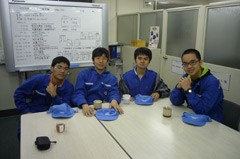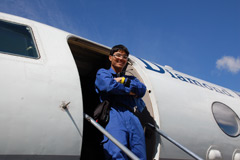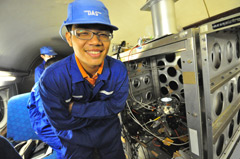Thai students participated in the parabolic flight campaign

Students from Thailand conducted a microgravity experiment, “A Study of Water Drops Spreading in Textiles under Microgravity,” during parabolic flights to Japan on March 25 and March 26, 2010. Mr. Jakrapop Wongwiwat, one of the students, gave his impressions of the experiment on the APRSAF website.
The story had begun when after a Japanese committee accepted our report and permitted us to conduct a special experiment for 20 s in a special parabolic flight. However, before conducting this experiment, we had to submit more data within 3 days. At that time, while I had insufficient data on this experiment, I hoped to be selected for the experiment on the spreading of water drops on textiles under the influence of microgravity. I knew that I had to make a greater effort to achieve my goal. To achieve our objective, my friends and I used to interact via the Internet to ensure that we had satisfied everything that was required for participation in this unforgettable experiment.

While many people may find the microgravity experiment very interesting and exciting since it was carried out under extreme conditions, the experiment simply involved investigating the spreading of water drops on the 6 textile materials, such as cotton, rayon, satin, nylon, and modified silk. Our preparations for this small-scale experiment in microgravity lasted more than 2 months because we had completeness of all instruments. The key factor that contributed to the success of our preparations for this experiment was that everybody in my group has a unique ability. Among my 4 team members, one was an expert in the field of microfluids, one in material technology, one was capable of analyzing all the obtained data by carrying out accurate image processing, and one had knowledge on how to design, purchase, and build all mechanical parts. This experiment would not have been completed if the composition of my team was different.

The preparation was the first stage of our travel to Nagoya airbase. While it was difficult for me to adapt to the changes in weather, the different lifestyle, and the different food, my determination to achieve the aim of this journey did not decrease. All the Japanese engineers were friendly, and they enthusiastically helped us to set up the experiment on the Gulf Stream II. My interactions with the Japanese engineers provided me with an opportunity to witness Japanese culture, e.g., their sincerity, diligence, and devotion to their work. I tried to converse with Japanese students, but I know little Japanese. However, this was not a problem because I tried to learn a new language. One can make new friends anywhere, regardless of the differences in nationality and language.

One of the most important parts of this experiment was floating for 20 s under the influence of microgravity in Gulf Stream II. All my body cells were sensitive to microgravity, and my nervous system tried to adapt itself. Every movement had to be made carefully because the conditions differed from those in swimming, or jumping from a table, or any other activity in my life. That was my special experience, which couldn't describe completely.

This experiment involved only the observation of the spreading of small water drops over small areas of the textiles under the influence of microgravity. Under these conditions, the fluid behavior changes. I hope that this small-scale experiment on microgravity and microfluids will serve as a basis for great innovations in the future, such as a lab-on-a-chip, and for understanding the mechanisms by which spreading of water in soil. While significant advancements continue to be made, we are a group of scientists and engineers who will continue to carry out research with the aim of realizing a comfortable life for everybody.
Photos on this article: © Diamond Air Service (DAS)